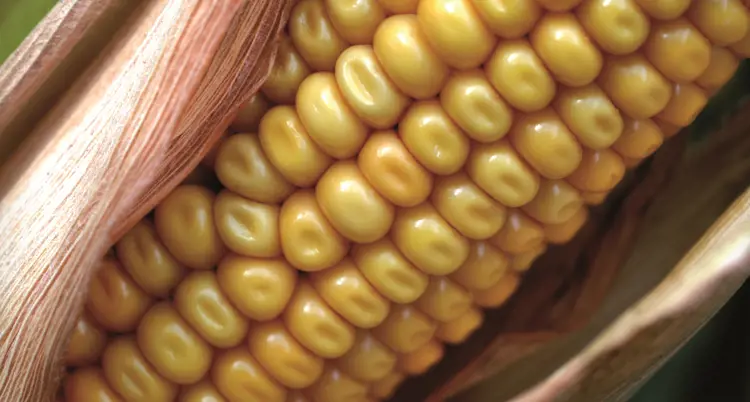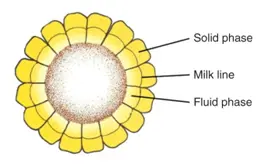Maize Silage
The age of the crop when it is harvested can influence the quality of the maize silage because it will affect the maize kernels, the moisture content and the digestibility of the silage. The rule of thumb to determine the correct age is to use the milk line on the maize kernel. The milk line is the transitional phase between the liquid and the solid part of the kernel. The optimum age is when the milk line has moved one half to two thirds away from kernel. However, using only the milk line can be misleading and may lead to silage being harvested too early or too late.

Importance of the age of the crop
Figure 1: Visual illustration of the milk line in maize
Other factors
Other factors to keep in mind when deciding if it is the right time to cut is the moisture content of the plant itself and the ratio between the grain and the plant, as that too will affect the final quality and dry matter of the silage.
When to harvest
Harvesting at the correct age ensures adequate sugar fermentation and adequate moisture for compaction as well as an optimum starch content. Cutting too early will lead to lower starch levels and lower dry matter yield per hectare. Studies done by De Heus and illustrated in Graph 1 shows the effect on the ton dry matter yield per hectare of silage as well as ton of starch per hectare and the starch percentage with only one week difference in cutting time over 6 different cultivars. The graph clearly indicates the effect of waiting one week on dry matter yield and starch content, with both dry matter yield and starch content increasing by one ton per hectare. Silage in our regions is often cut weeks too early and the effect on yield is now clear to see.
The other side of the coin is not to wait too long, as silage which becomes too mature would yield good starch but a much lower rate of digestibility. Dry silage also has a tendency not to be so well compacted, which leads to a large amount of losses and poorer quality roughage.
When one makes use of larger quantities of roughage it is important to realise the importance of good quality roughage as a basis. The better the quality of roughage produced on the farm the smaller the amount of additional feed is required. Looking at multiple factors when deciding when to harvest will improve results. Because De Heus wants to become a partner in a farmer’s business in the long term we also started focusing on finding ways of improving the roughage quality on the farm together with farmers. The implementation and use of international concepts such as OptiMaize and increasing awareness of quality issues and factors which improve them has reaped rewards. The results of these programmes are evident in the improvement shown in the quality of roughage produced by dairy farmers in South Africa over the last few years as illustrated in.
Graph 2: Improvement of Maize Silage Quality in Starch Content and VEM over a 3 Year Period
OptiMaize
The OptiMaize harvest card is a quick and simple tool to help determine when it is the optimum time to harvest maize silage. Although the card is not an exact scientific tool, it does improve the accuracy of harvest time dramatically. Using different concepts and working together with farmers these improvements in roughage quality combined with the use of the SynchroFos system has improved efficiency of several dairy farming units. The dairy industry keeps on evolving and dairy farmers are forced to become more efficient daily. If you are unsure or want guidance when making these very important decisions, feel free to contact your De Heus technical advisor at any time and make use of the tools given to you as farmer.

